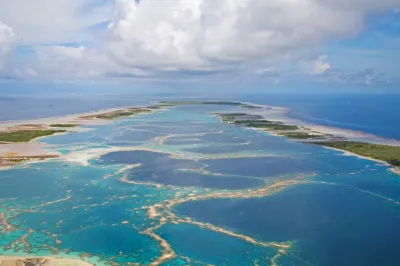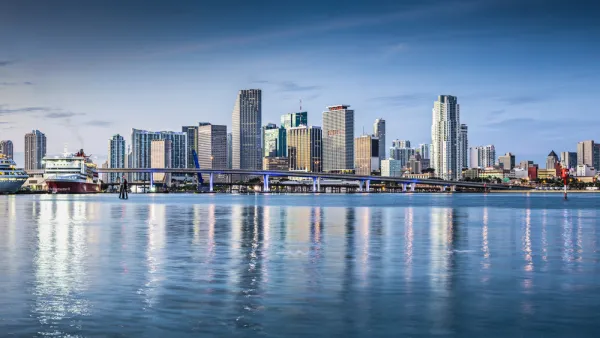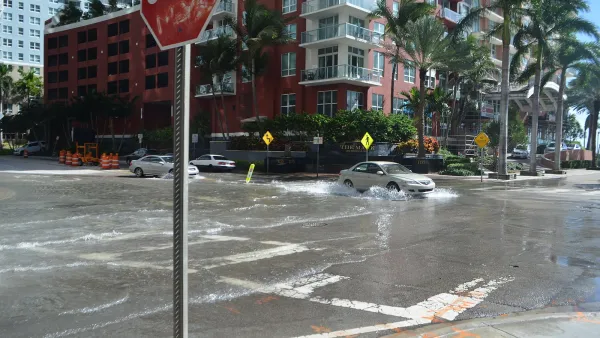As the climate warms, the world's glaciers and ice sheets are melting, but sea level increase will be greater in some places due to the earth's rotation and gravity, according to a newly released study by the NASA Jet Propulsion Laboratory.

How much can you expect rising sea levels to threaten your coastal city? The answer lies in part in knowing which glacial ice melts affect it, so planners can determine how much of an increase to prepare for.
"NASA's Jet Propulsion Lab has mapped how changes in these giant ice fields influence sea levels both nearby and thousands of miles away," reports Christopher Joyce, science correspondent for NPR (audio available). "They published their results in the journal Science Advances."
It turns out that in New York City, the sea level would be affected more by melting ice on the northern end of Greenland than much closer ice in southern Greenland, or even ice in Canada.
Scientists are now using this information to predict the future for American cities, but they're also building in a lot of local geographical information.
"The National Oceanic and Atmospheric Administration (NOAA) is putting together a sea level rise grid for the country, one that will factor in local conditions as well as the effects of faraway melting ice," adds Joyce.
Sea level decrease?
Yes, melts in the eastern Greenland ice sheet could cause a minor drop in sea level in Norway while raising sea levels off Tokyo by several inches, writes Joyce.
============================================================================================================================
Jeff Goodell’s new book, The Water Will Come: Rising Seas, Sinking Cities, and the Remaking of the Civilized World was reviewed by Jennifer Senior for The New York Times on Nov. 22. While Joyce of NPR indicates that sea level has risen an average of eight inches over the last century, Senior writes that the authors of climate reports for the 2015 Paris agreement estimate sea level rise at over three feet by 2100.
Now many scientists believe that estimate is too low. Some say the sea could rise as much as six feet; others say even more than that.
“For anyone living in Miami Beach or South Brooklyn or Boston’s Back Bay or any other low-lying coastal neighborhood,” Goodell writes, “the difference between three feet of sea level rise by 2100 and six feet is the difference between a wet but livable city and a submerged city.”
"Of all the American cities in this book, Miami seems least equipped to handle a rise in sea level, founded as it is on pleasure, real estate and the inalienable right to not pay state income taxes," adds Senior.
FULL STORY: The Sea Level Threat To Cities Depends On Where The Ice Melts — Not Just How Fast

Analysis: Cybertruck Fatality Rate Far Exceeds That of Ford Pinto
The Tesla Cybertruck was recalled seven times last year.

National Parks Layoffs Will Cause Communities to Lose Billions
Thousands of essential park workers were laid off this week, just before the busy spring break season.

Retro-silient?: America’s First “Eco-burb,” The Woodlands Turns 50
A master-planned community north of Houston offers lessons on green infrastructure and resilient design, but falls short of its founder’s lofty affordability and walkability goals.

Test News Post 1
This is a summary

Analysis: Cybertruck Fatality Rate Far Exceeds That of Ford Pinto
The Tesla Cybertruck was recalled seven times last year.

Test News Headline 46
Test for the image on the front page.
Urban Design for Planners 1: Software Tools
This six-course series explores essential urban design concepts using open source software and equips planners with the tools they need to participate fully in the urban design process.
Planning for Universal Design
Learn the tools for implementing Universal Design in planning regulations.
EMC Planning Group, Inc.
Planetizen
Planetizen
Mpact (formerly Rail~Volution)
Great Falls Development Authority, Inc.
HUDs Office of Policy Development and Research
NYU Wagner Graduate School of Public Service




























